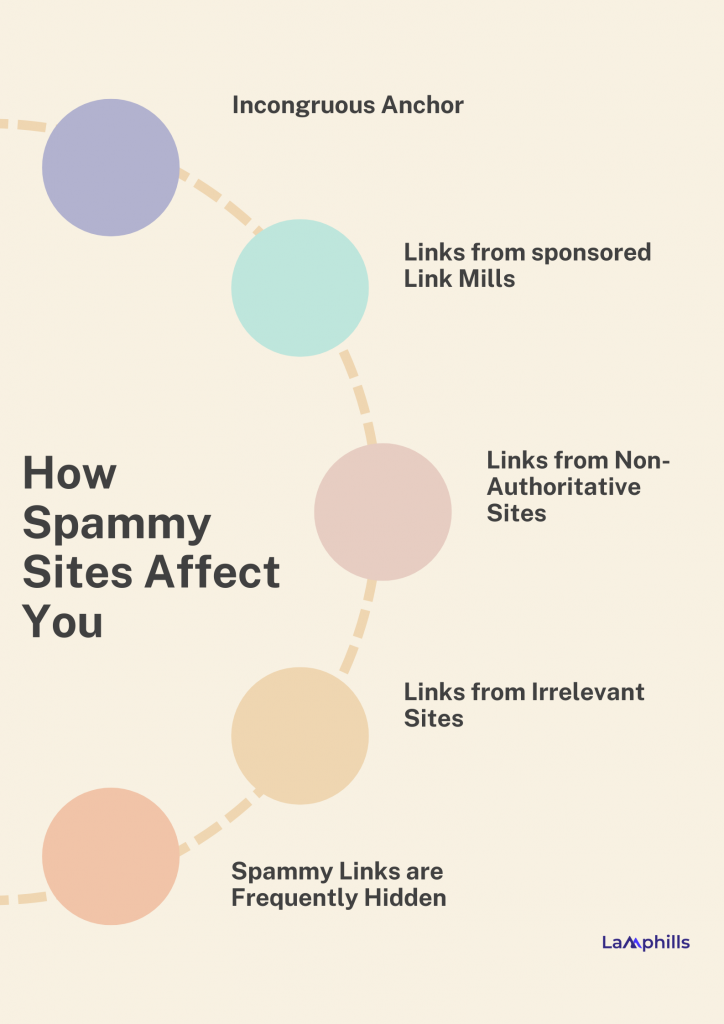I’ve worked in digital marketing for years, and few things make me more angry than sketchy, spammy sites that try to get around the rules. You know the ones I’m talking about—they’re full of thin, stolen content and ads and only exist to steal traffic and authority from real businesses.
We work hard to make good content and build a strong online brand, only to be caught off guard by spammers wearing black hats and hurting our reputation. If you find out that your brand is linked to or connected with such a spam hole, it can instantly undo months of hard work.
Okay, enough is enough. I figured since I have the experience you can use this expert help as a defense against the shadiest spammers out there. I’ll list the telltale signs of ultraspammy websites so you can spot risks right away and deal with them.
Key Takeaways
- Plagiarized content, frequent spelling and grammatical errors, and irrelevant information are all indicators of low-quality, spammy websites.
- Spammy sites have an overwhelming presence of advertisements, particularly obtrusive pop-ups and enticing titles.
- A spammy site will have many unsolicited redirects, urges for malware downloads, and phishing efforts to collect personal information.
- An “About Us” page, or author data, along with phoney reviews and testimonials, weakens a website’s credibility. Transparency is an important feature of trustworthy websites.
- Unusual domain names, obsolete or generic web design, broken links, and the lack of HTTPS encryption all indicate that a site may be spammy.
What Is A Spammy Site?
Spammy sites are backlinks that are inserted on pages and websites by webmasters or page builders. These links are unrelated to the user’s experience or the page’s context.
From Where Do Spammy Sites Originate?
Because SPAM sites are as ancient as the Internet itself, most individuals will be able to identify them, at least generally, merely by hearing the term used. However, not everyone has a strong grasp of the Internet, thus it’s critical to clarify what precisely constitutes a spammy site. In a nutshell, Spammy sites are like fleas on the hide of your digital puppy, which, for the sake of analogy, might be any website, including yours. They are a huge annoyance to anybody they affect since they take without offering anything in return.
Spammy links originate from several prevalent dubious or forbidden link-building strategies, such as:
#1. Poor-Quality Article Databases
Many content farm websites accept articles in exchange for backlinks, and they display the pieces on their servers. The writer offers a piece that is jam-packed with relevant keywords and backlinks directing readers to their website. They get a fresh backlink from every website it appears on in exchange. But in reality, these directories are nothing more than link farms that use auto-generated or recycled content to host more links. For real readers, the value is negligible to nonexistent.
All of these methods go against the prohibitions on using fake link-building strategies. The links, which range from content farms to integrated networks to scraped spam, are not there to help users; instead, they are there to take advantage of search engine algorithms. Because of this, search engines will quickly demote or ban them if they are found.
#2. Automated Software and Services for Link Building
Some firms use unauthorized website scraping and spamming to quickly create links at scale. Many people submit links in their blog entries, forum profiles, and comments automatically or at random. The rapid flood of links that followed seems very odd. For such overt spamming, websites are frequently discovered and banned.
#3. Private Blog Networks (PBNs)
A PBN is a network of fictitious blogs and websites that are connected covertly. The network is run by a company whose main goal is to manipulate PageRank flow between its properties; by channelling authority and signals internally first, the network creator hopes to elevate some sites to the point where they can then affect external search rankings.
How do you spot spam sites?
Sites pointing to your domain from low-authority or spammy websites are referred to as spammy sites or low-quality backlinks. A sudden increase in traffic to your domain, frequently from nations other than those of your target audience, makes them easy to spot.
Spammy sites may appear as one of the following:
#1. The Poor Caliber of Guest Posts
A successful link-building strategy is built around well-written guest articles that add value to a platform’s user experience and give visitors important information. When a customer offers a helpful resource or knowledge on the subject at hand, links should be organically included in the articles.
Naturally, a lot of SEO experts ignore this step of the procedure and instead, squeeze client links into anchor text that is either awkward to read or doesn’t fully fit with the rest of the sentence. No matter the platform, these pieces might just be a few hundred words long; the Penguin algorithm, which favours longer content, disapproves of this as well.
#2. Spam in Comments and Forums
I remember when encountered a spammy link, and it was when I was regulating comments on my blog. These took the shape of endorsements of the original post followed by a suggestion to read the link. This kind of spam frequently includes several links from the same post and can also appear on forums in the form of new posts or comments.
#3. Directory Sites
After the Penguin algorithm change, directories were once a common way to establish links. They are still infrequently utilized today. Like any other content platform, site directories that let you add your website without any additional editorial review should be avoided. Submitting to any directory, though, could end up doing more harm than good. As long as they are relevant locally, of course, some directories can help with local SEO.
How Spammy Sites Affect You

#1. Incongruous Anchor
Because searchers click on anchor texts—like the words “anchor texts” in this sentence—to reach a particular link, anchor texts, and URLs are tightly related.
Because the search engines can better grasp what you are dealing with on the linked site or page, using an anchor text relating to the material you are publishing or products you are selling is a tried-and-true method of commanding high ranks and conversions.
#2. Links from sponsored Link Mills
Verifying if a link originates from a sponsored link scheme is another technique to spot a fraudulent one. These are links that are marketed to website owners as a quick fix for increasing their ranking through backlinks, either as part of a package or separately. It’s crucial to remember, though, that search engines are now aware of this tactic.
They specifically penalize the websites that use link mills when they find them since they break webmaster standards.
#3. Links from Non-Authoritative Sites
Popular and reliable websites frequently provide high-quality backlinks, which are very beneficial for raising your ranks. This is essentially the idea of “domain authority,” according to which Google favours sites with a high DA and dislikes those with a low DA.
#4. Links from Irrelevant Sites
It is useless to link to a well-established, respectable website if it has content irrelevant to the page you wish to link to. Links from related websites are usually preferred by Google since the search engine typically seeks out relevant content with extra information.
Even though a lot of people may find your page to be their favourite, you won’t benefit from linking it to an unrelated website. It will lower your ranks and cause red flags!
#5. Spammy Links are Frequently Hidden
Text manipulation, background colours, and other techniques are frequently used to hide spammy links from users and search engines. This is against Google’s search engine guidelines and may result in fines and a website downgrade.
Five Reasons Why Your Website Is Affected by Spammy Sites
#1. Penalties on Google
A large number of low-quality connections on your website may result in a penalty from search engines like Google. Your website may experience a decrease in search engine ranks or may be completely removed as a result of these penalties.
Being able to disavow backlinks reduces the possibility of receiving such a penalty.
#2. Adverse Search Engine Optimization
Competitors or nefarious individuals may occasionally build or obtain low-quality backlinks to your website in an attempt to lower its search engine rankings. We refer to this as bad SEO.
By rejecting these harmful connections, you may shield your website from unethical SEO tactics and let search engines know that you do not support or cooperate with them.
#3. Ineffective SEO Results
In general, poor backlinks pointing to your website hurt your SEO. Gaining the ability to identify and eliminate low-quality backlinks can help you raise the overall standard and relevancy of your backlink profile. Better SEO performance, more organic traffic, and higher search ranks can result from this.
#4. Subpar Connection Quality
Inappropriate or spammy sites can weaken the authority of your website and hurt its functionality. It’s important to know how to delete bad backlinks so that the links in your backlink profile are relevant, high-quality, and support your SEO efforts.
#5. They Impair the Reputation of Your Brand
Poor-quality or spammy websites that connect to your website may harm the reputation of your company. By removing untrustworthy connections, you can keep your backlink profile credible and clean, protecting your online reputation and brand image.
How Spammy Sites Affect SEO Positions
It’s no longer news that outdated spam backlinks lower rankings. In actuality, there are several types of backlinks available today that lower your website’s position. Antiquated spam backlinks merely increase the number of visitors to your website that leave because of the volume of backlinks originating from you. If your website contains these hyperlinks, locate them and remove them immediately. Without a doubt, they are harming your search engine results, driving visitors away from your website and eventually, your business. Make sure to finish up some further backlink maintenance while you are on the website removing these outdated backlinks.
A few ways spammy sites can affect:
#1. Google and Links from Untrustworthy Websites
Many argue that links from untrustworthy websites won’t cause Google to lower your site’s ranking. Indeed. Inbound links from low-quality websites will indeed lower your score just as much as outdated spam backlinks, according to recent publications from leading SEO specialists. If you want your website to remain highly ranked by Google, you will need to understand what these connections are, where to locate them, and how to remove them.
#2. Updated Insecure Links
Building new backlinks with the wrong method is a double-edged sword, as old spammy backlinks are already detrimental enough. With so much competition, links that are unreadable and jam-packed with keywords or that point to unrelated websites are becoming more and more common. Google has to alter the algorithms and make life more difficult for these offenders for precisely this reason. After you get rid of all those annoying old spam backlinks that are dragging your site down in the rankings, new backlinks will become your site’s new worst enemy.
How I Identify Spammy Sites & Deal With Them
You should understand the importance of backlinks whether you’re a marketer, entrepreneur, founder, or company owner looking to improve your website’s search engine rankings.
Not all backlinks are created equal. Some might be harmful to the SEO of your website.
I’ll demonstrate how I find and remove harmful backlinks in this section.
#1. Finding Untrustworthy Backlinks
Finding the problematic backlinks is the first step toward removing them. These are, as we’ve already talked about:
- Links from ad-filled, low-quality spamming websites.
- Links from irrelevant specialized websites that are unrelated to your target market or business.
- paid links created specifically to skew search engine results.
#2. Google Catalog
Another useful tool for locating problematic backlinks is Google Search Console, which lets you download data in CSV format for additional research and displays the websites that connect to yours.
These programs helped me eliminate the tedious task of manually sorting through every link on my website to identify the harmful ones. They make it simple for you to locate incoming links that search engine spiders may mark as spam.
#3. Ahrefs
Ahrefs is a great tool for backlink audits and backlink profile analysis for websites. Also, Ahrefs’ extensive database of current backlinks is updated daily, and its filtering options include domain rating (DR), anchor text distribution, and other criteria that help you find potentially dangerous connections.
Also, not only provides you with a ton of backlink information, but it also allows you to disavow links directly from the program.
Additionally, it allows you to personally review the links in your audit to ensure that every connection you want to disavow is truly harmful. When finished, you can obtain your list of malicious backlinks in a format that you can upload, if required, to Google Search Console (GSC). In a bit, more on this.
#4. Moz Link Locator
Another well-liked choice for marketers looking to perform backlink audits on their websites is Moz Link Explorer. It provides you with comprehensive information on the link health status of your website and a thorough study of your backlink profile. Moreover, it offers a spam score measure too.
How to identify spammy links?
- The sudden and rapid surge of links from unrelated websites.
- Links coming from the same server network or IP range.
- websites that link with almost the same anchor text.
- Many links from websites with extremely poor metrics for trust or domain authority.
What are spam URLs?
To improve search rankings, backlinks that are thrown onto pages and websites without consideration of context or user experience are referred to as “link spam.” Link spam is strictly prohibited by search engine guidelines, which also penalize or devalue spammy links.
Where do spammy backlinks come from?
Spammy backlinks are essentially connections that originate from unreliable sources or have been altered to raise the ranking of the connecting site. They are also sometimes referred to as nasty, toxic, or low-quality backlinks.
How do spam links work?
A con artist will try to trick a victim into clicking on a harmful link by assuming the identity of a reliable source. Following this link may result in the download of malicious software or the disclosure of private data, including bank account information.
Conclusion
Spammy sites can come from a variety of places, and occasionally, it’s not even your fault that your website gets linked to spammy backlinks. But spammy sites are linked to spammy websites in the search engine’s sight.
For this reason, it’s essential to routinely examine the backlink profile of your website to spot and eliminate any spammy backlinks. Fortunately, the work, when completed daily, won’t require much time or effort because of SEO tools like RankWatch. The short amount of effort you will need to invest in locating and eliminating spammy backlinks is a tiny price to pay to protect the ranking of your website in search results.
Related Articles
- 13 Press Release Headline Examples to Inspire You (+ Free Tips)
- SEO Reputation Management: How I Protect & Enhance My Online Presence
- 9 Personal Branding Hacks for Insane Growth in 2024
- WEBSITE TITLE VS ARTICLE TITLE: Differences & Examples
- Spam Backlinks: The Silent Saboteurs of Your Website’s Credibility






